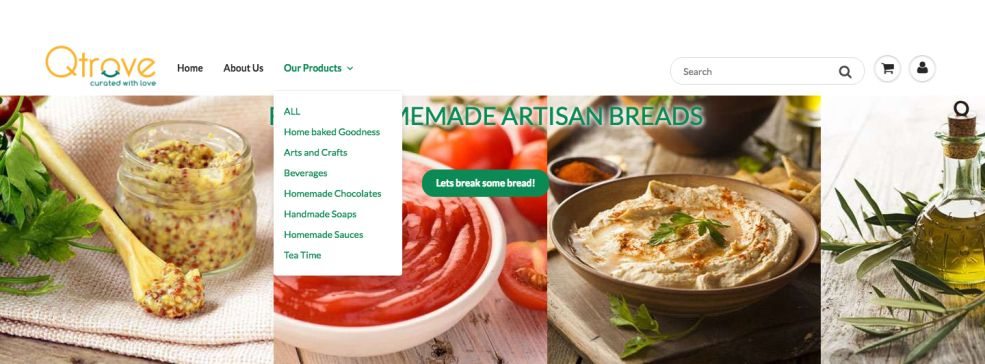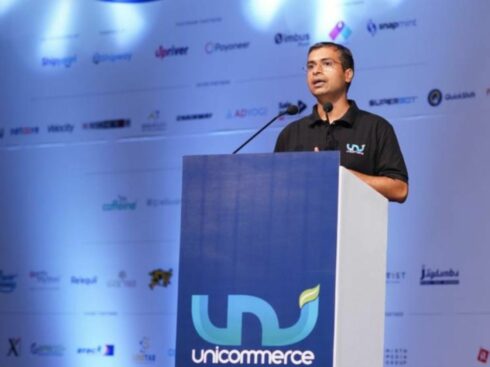All curation grows until it requires search. All search grows until it requires curation – Benedict Evans
Traditionally, the practice of curation was restricted to arts, antiquities and literature – with auction houses such as Sotheby’s, Christie’s becoming world famous for the one-of-a-kind, rare treasures they produced for willing patrons. These treasures often cost astronomical figures and are, in some ways, more of a status symbol for the wealthy.
But the basic notion of curation – that of handpicking and individually selecting an item, ensuring provenance (authenticity) before placing it for sale is one that can be translated to virtually any vertical – given that we live in a technologically forward world. It can, given the right incentive and communication, become a way of life.
With this inspiration in mind, a couple of experienced entrepreneurs Vinamra Pandiya and Prashant Nagarajan, embarked upon a journey to create this same curated experience online by starting up Qtrove (curated trove) in late 2015 out of Bengaluru. The startup aims to offer handmade non-mass produced food, upcycled fashion, beauty, and bath items made from natural, organic and sustainable ingredients.
“I was actually inspired by an article I read on NatureBox – this company in the US that curates healthy snacks,” confesses Vinamra, co-founder of Qtrove. “In 2015, foodtech was still considered to be at its peak even though it was slowly losing its charm. So, I took a different approach in foodtech – by wanting to creating a brand for curated, packaged, healthy snacks for the modern India.”
Qtrove has now grown to 200 sellers across India selling 3,000+ products in 40 categories (across food and beverages, bath products, fashion and household items as well as pet care) on the platform with about 500 orders coming per day with an average ticket size of INR 600. The company boasts of a fairly even demographic between male and female users, leaning slightly more towards female users on account of categories such as upcycled fashion, bath and natural beauty products.

The GrowthStory Connect
For Vinamra, having spent close to a decade in the foodtech industry – first with TastyKhana (which was acquired by foodpanda in late 2014) and later on with foodpanda India – the prospect of continuing his association with the space held a lot of appeal.
To this end, he utilised his contacts and ended up having a discussion with K Ganesh, Partner at GrowthStory regarding the direction he wanted to end up in. The idea crystallised from this need to do something in the foodtech plus curation space. This eventually turned into a curated marketplace with complete control when it comes to products on the vendor (seller) as well as buyer side. On asked why GrowthStory chose to back Qtrove, Ganesh says,
“Vinamra’s core idea was to build a marketplace which is anti-ecommerce in its approach, was serving a noble purpose of empowering local entrepreneurs, and giving today’s discerning consumers a dash of natural, sustainable and handmade products.”
The startup also managed to raise an initial amount of angel ending from GrowthStory’s platform at this point in 2015. Ganesh adds, “I’m backing them as Qtrove resonates with GrowthSory’s founding principle – Building tomorrow’s giants.”
Of course, the concept of a curated marketplace was well and good but it needed to be tested out in the Indian market. So the first task for the founder was to test out the hypothesis of this kind of business model and also look out for sellers in Bengaluru who fit the parameters and would be willing to come onboard on a new platform.
Vinamra scoured a mix of online and offline mediums to narrow down on – from sellers in nearby localities who sold specialist, handmade chocolates, fudges etc. to small businesses operating on WhatsApp groups and Facebook groups. These people were operating purely on word-of-mouth, even though, as per Vinamra, they were present on the bigger marketplaces – Amazon, BigBasket and the likes.
“But the thing with these sites is – they do not give due importance to the lower rung, low volume producing sellers. Their SEO works on larger volume of orders, so these sellers’ rankings were affected.”
He adds that the traditional ecommerce marketplace is driven by bulk quantity orders of branded or well-known products whereas smaller sellers were bottom of the rung, in the long tail. These sellers were listed on these platforms due to lack of other alternatives.
For the company, the target audience, boiled down to the new Age millennial consumer – someone in their late 20s-45 years of age, with a good amount of spending income, and someone who is well-travelled. As per the founders, they are discerning customers who understand the importance of curation and are willing to spend on such items than saving up on discounts – they will take the next step. That of purchasing these organic, sustainable products on a monthly basis, turning Qtrove into a lifestyle choice by providing staple products
It was also around this time that Vinamra was introduced to Prashant who was managing Grofers in South India and, after a few discussions, he came onboard as the co-founder balancing business ops with marketing.

Democratising Ecommerce: The Etsy Way
Vinamra was able to find initial interest from about 10-15 sellers in Bengaluru who were looking for a horizontal marketplace to ‘blindly purchase curated products.’ This led to the creation of the actual product. With a three people team, the first version of the website was built on Shopify – which counts 243,000 merchants right now on its cloud-based, omnichannel, retail commerce platform, worldwide.

Qtrove operates as a closed marketplace with a variety of QC checks in place to ensure the quality of products available on the website. The testing of these products – for instance, food such as handmade chocolates, is ensured by their team, beginning with the kind of ingredients used to prepare the product. “For chocolates, the acceptable natural ingredients are cocoa and butter. No emulsifiers or colouring agents. For candles, no paraffin wax, we look for natural ingredients such as beeswax, among others.”
They also believe in telling stories – not just selling products. The Qtrove’s Storyteller team (in-house team of photographers, freelance video team and more) ensures that each product is shot artistically and aesthetically. As the products on the platform are not of the standard variety, it was important to highlight the essential uniqueness of them – and to tell their journeys through images.
Ganesh iterates that Qtrove’s ethos is similar to that of Etsy and Ebay where community and content comes first, followed by commerce. “This is a new concept,” he says. “But if it succeeds, then it would be a big success with fairly good barrier-to-entry moats.”

Vinamra adds, “And each of our sales is based as much on the product as it is on the content. Customers need to come, linger and browse before making up their mind.” The stickiness of the website is a major go-to strategy for Qtrove – rather than how cheap or discounted the prices are.
The average Qtrove user logs onto the completely automated platform where the first-time user gets a slight push through a marginally discounted strategy (completely on the onus of the seller), to avoid cart abandonment. The focus is more on ‘sticky bots’ and exit intelligence to bring the customer back to the platform.
As per Vinamra, the website is not looking to entice customers with enormous discounts and earn customer loyalty. In fact, they even charge for shipping. The more the number of products, the more the shipping costs. Sellers are the core focus of the platform – as the products are not MRP-based, the margin of profit is high. Qtrove charges anywhere between 25%-40% in commission.
This approach is markedly different from the traditional ecommerce marketplace, where each second counts when it comes to customer conversion and volume bulk orders lead to profitability. To this Ganesh responds with, “Qtrove is not competing with the big daddies. In fact, the team wants to create a new space where products are bought not based on the discounts but based on their intrinsic value and their sustainability.”
“Qtrove is not competing with the big daddies. In fact, the team wants to create a new space where products are bought not based on the discounts but based on their intrinsic value and their sustainability.”
The Numbers Game: Scaling Up Step By Step
Qtrove’s strategy has been to scale up gradually. It began with a handful of sellers and 40-50 products in the beta phase which led to the first few orders (mostly from friends and family). The primary hurdle here was to get word-of-mouth out to the consumers in Bengaluru, the initial testing ground. But testimonials, came to the rescue, with personal recommendations following a close second.
This led to the company increasing logistics reach to access pan-India, tying up with Delhivery, FedEx, India Post. As per Vinamra, in October 2016, the company was doing 10-15 orders with an average ticket size of INR 300-INR 400.
As with any retail business working on the omnichannel model, Qtrove too followed the route of offline outreach. They set up stalls in exhibitions, approached corporate houses for corporate gifting. Also, due to their commitment to sellers, the sellers started recommending the website to form an expanding community with stickiness and trust at their core.
They also consciously utilised a different kind of online marketing strategy, choosing to focus on the authenticity of the products. “After figuring out the closed, curated marketplace product proof-of-concept, our next big challenge was finding the answer to this question – will customers buy on a platform that does not offer large discounts and charges for shipping?”
The answer lies in the figures – Qtrove has now expanded to include food items, natural beauty, household, petcare and grooming categories on the website and is now clocking about 300-500 orders per day, as disclosed by the team.

Creating Brand Recall For User Retention
Qtrove counts Amazon, Flipkart, Snapdeal, Shopclues, Big Basket, Grofers among others as competition – on the simple principle that each of these platforms play in the same ecommerce wheelhouse as the nascent startup. But due to its inbound marketing, community-focussed strategy, with validation happening on both the seller and buyer front, the concept of curation is what differentiates it from the others.
But as Ganesh already mentioned, Qtrove is categorically anti-ecommerce in its approach. So, it also counts specialised marketplaces such as Jaypore (IndianMe), Love This Stuff, AfDay (defunct), ItsHandMade (defunct) among others. Internationally platforms such as AhaLife offer the curated marketplace experience. One of the key things to note here would be that platforms such as Jaypore deal with high-end or upcycled fashion and accessories. Aha is a global contender catering to the spectrum of urban lifestyle living through ‘premium products.’
Vinamra emphatically adds here, “We are not positioned as a premium or a niche brand, but rather as a curated brand. In the sense, that our products, say handmade chocolates or soaps – they are not all perfectly cut and shaped. The imperfections is what makes it a curated experience. It’s this lifestyle value (LTV) of the brand versus the traditional customer acquisition cost, to ensure continued profitability that we are banking on.”
He also adds that they adopted a pull strategy from the beginning, where seller recommendation was one of the most important targets. “As for competition, it is required to create a larger, healthy market, isn’t it? Competition validates the market – both in terms of need, and in terms of demand and supply.”
But, as per Vinamra, the company chooses to focus on its own path and carry on with business as usual. While he does admit that no business can operate in isolation, it is important to focus on the key tenets of their own business model – namely telling interesting stories to create user stickiness and creating an engaged community of sellers and consumers.
It is this need to create user retention that has propelled the next stage in Qtrove’s product hypothesis. Namely, that of creating brand recall in order to become part of the consumer’s monthly budget. “Repeat orders are what we are going for next. With a combination of traditional and modern methods of automation (he mentions email/push notifications) to help remember us as a brand. To use Qtrove products in place of other brands – be it for groceries, soap, or hand washes or shower gels.”
Achieving success at this level of scale will bound to create a barrier of entry for existing incumbents and newcomers to crack, something the 10-member team in Bengaluru is counting on as it looks to hit the right kind of numbers to raise external funding and scale the world.

Editor’s Note
The modern millennial consumer is hyperconscious of their lifestyle choices – be it sleeping the proper amount of hours, talking about mental health issues or, as in the case of Qtrove, buying the right kind of products. The idea of curation is not new but the execution of it a democratised process is certainly novel, in India which has also seen shutdowns in the space with AfDay, ItsHandMade etc. Also, the larger ecommerce picture with giants like Amazon, Flipkart, Paytm jostling for top spot cannot be ignored, even if Qtrove’s business model is determinedly seller-friendly.
Qtrove’s founder experience counts to their advantage – the founders always look to test out the hypotheses (in terms of product, customer retention) before scaling cautiously. Plus, the GrowthStory connect also cannot be overlooked. Given the consolidation taking place amongst the top players, the time seems to be ripe for a newer startup to occupy a place with a different kind of ecommerce philosophy. But how far will just testing out the hypotheses go for Qtrove, how much will it be able to grow and convince the average Indian millennial to repeat orders consistently and at scale will decide the startup’s fate.



























